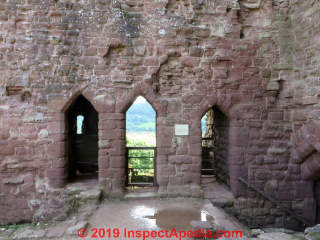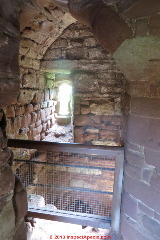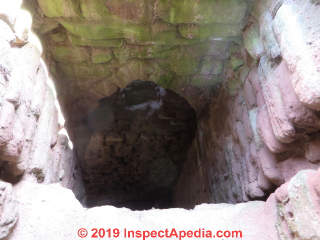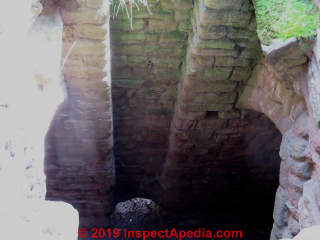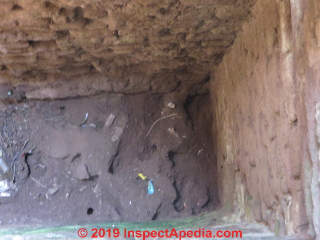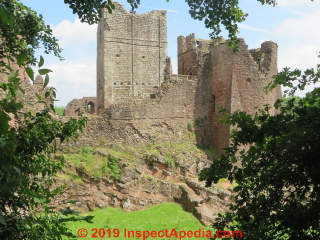 Goodrich Castle, Ross on Wye
Goodrich Castle, Ross on Wye
The Latrine Tower - an early indoor toilet system
- POST a QUESTION or COMMENT about early toilet designs, use, maintenance & repair
The Goodrich Castle latrine tower is described here.
Antique toilets and sanitation systems included an early indoor latrine system constructed in the twelfth century around 1150 A.D. in Goodrich Castle at Ross on Wye in Herefordshire, England.
Page top photo: approaching Goodrich castle you can see that it was built on an upthrust of sandstone rock that both formed a high spot overlooking the river Wye and the Herefordshire countryside. The stone also provided a solid foundation for the structure. In the page top photo we are looking across part of the castle "ditch" or moat system at the castle's left side.
First constructed of wood and mounded earth, as early as 1050 A.D. Goodrich castle guarded the line of the former Roman road from Gloucester to Caerleon as it crosses from England into Wales. Subsequent stone construction was completed around 1150 and three large corner towers around 1280 A.D.
The south-eastern corner tower is at the right side of the photograph above. The right-angled spur against the southeast tower wall was built of solid stone and was intended to make it difficult to undermine (and thus collapse) the tower during a siege.
This article series describes early sanitation systems, chamber pots, outhouses, latrines and flush toilets such as the high-cistern flush toilet.
InspectAPedia tolerates no conflicts of interest. We have no relationship with advertisers, products, or services discussed at this website.
- Daniel Friedman, Publisher/Editor/Author - See WHO ARE WE?
The Latrine Tower in Goodrich Castle, Herefordshire
 The Latrine Tower in Goodrich Castle, Ross on Wye, Herefordshire, England, whose construction began ca the year 1080, was visited by the author in 2014. (No I did not actually use the latrine at that time.) This is one of the earliest examples of an indoor toilet system in England.
The Latrine Tower in Goodrich Castle, Ross on Wye, Herefordshire, England, whose construction began ca the year 1080, was visited by the author in 2014. (No I did not actually use the latrine at that time.) This is one of the earliest examples of an indoor toilet system in England.
For the wealthy an alternative to chamber pots shoved under the bed or to a wooden close stool was the "indoor" latrine found in some grand estates and castles such as the Goodrich Castle latrine tower. In essence, the outhouse was moved safely to inside the keep - inside the castle walls, thus in a sense forming an early indoor toilet system.
Goodrich Castle was probably built by Godric of Mappestone after the Norman invasion of England, initially as an earth and wooden fortification.
In the middle of the 12th century the original castle was replaced with a stone keep, and was then expanded significantly during the late 13th century into a concentric structure combining luxurious living quarters with extensive defences. - citations below.
This photo shows the medieval castle's southeast tower and the castle's "front" wall against the center of which the latrine tower was constructed. The latrine's cesspit drained into the moat seen in the center of the photograph.
The entry ramp to Goodrich Castle is seen in the distant right side of this photo.
A castle drawbridge system raised an access ramp to protect the castle if under attack.
Perhaps the fact that the cesspit drained into the moat added to its effectiveness as a security barrier.
The latrine tower's three alcoves or chambers are shown below, viewed from inside the castle.
The three individual latrine chambers shown below correspond to the left, center, and right latrine tower openings in the more broad view offered by the photo above.
This latrine tower, used by "the public" occupants of the castle, had three seats (and a lovely view). Users who stood facing what would have been a wooden seat with a hole and perhaps a cover, would have seen the view shown in our second photo just above. The center tower combined with the larger window opening as well as smaller openings in the left and right towers also vented the latrine to outside the castle walls.
The Goodrich Castle latrine tower was constructed of three deep shafts, each ending in a common rectangular cesspit.
Our additional photos show a vent in the latrine shaft and the bottom of the cesspit.
Below: From the cesspit a hole drained into the castle moat, making that security barrier even more un-appealing to anyone hoping to breach the castle walls.
Through that hole a small boy was occasionally sent to clean out the cesspit itself. The castle lord and lady did not use this latrine tower. Instead a separate, private latrine was provided for their quarters.
The Romans constructed indoor latrines and toilets well before the Normans and Goodrich Castle's latrine tower. Romans constructed enclosed toilet systems such as those found at Ephesus and, more advanced than the Goodrich latrine tower, even tried using running water to flush toilets into a drainage system such as the Roman Colaca Maxima.
However disposal has never been the same as effective treatment (sanitization) of sewage, a point I argue throughout all of our articles on septic and plumbing systems. Parasites and disease were still abundant and actual sanitation has been described as poor. (Mitchell 2017)
References: Goodrich Castle & Roman Toilets
- Faulkner, Patrick A. "Castle planning in the fourteenth century." Archaeological Journal 120, no. 1 (1963): 215-235.
- Goodrich Castle, English Heritage, UK Website: https://www.english-heritage.org.uk/visit/places/goodrich-castle/ The text below is adapted from Wikipedia entries and other sources.
Goodrich Castle appears to have been in existence by 1101, when it was known as Godric’s Castle, named probably after Godric of Mappestone, a local Anglo-Saxon thane and landowner mentioned in the Domesday Book of 1086. Victorian historians, however, believed the castle to date back further to the pre-Norman conquest days of King Canute, and the site may have been among a small number of Saxon fortifications along the Welsh border.
by Norman times, Goodrich formed part of the Welsh Marches, a sequence of territories granted to Norman nobles in, and alongside, Wales. Although Goodrich lay on the safer, English side of the border, the threat of raids and attacks continued throughout most of the period.
Goodrich Castle is a Norman medieval castle ruin north of the village of Goodrich in Herefordshire, England, controlling a key location between Monmouth and Ross-on-Wye. It was praised by William Wordsworth as the "noblest ruin in Herefordshire"[1] and is considered by historian Adrian Pettifer to be the "most splendid in the county, and one of the best examples of English military architecture".
Goodrich Castle was probably built by Godric of Mappestone after the Norman invasion of England, initially as an earth and wooden fortification. In the middle of the 12th century the original castle was replaced with a stone keep, and was then expanded significantly during the late 13th century into a concentric structure combining luxurious living quarters with extensive defences.
The success of Goodrich's design influenced many other constructions across England over the following years. It became the seat of the powerful Talbot family before falling out of favour as a residence in late Tudor times. Held first by Parliamentary and then Royalist forces in the English Civil War of the 1640s, Goodrich was finally successfully besieged by Colonel John Birch in 1646 with the help of the huge "Roaring Meg" mortar, resulting in the subsequent slighting of the castle and its descent into ruin.
At the end of the 18th century, however, Goodrich became a noted picturesque ruin and the subject of many paintings and poems; events at the castle provided the inspiration for Wordsworth's famous 1798 poem "We are Seven". By the 20th century the site was a well-known tourist location, now owned by English Heritage and open to the public. - Wikipedia June 2019 - Beck, Julie, Roman Plumbing: Overrated (2016), retrieved 2019/06/20, original source: https://www.theatlantic.com/health/archive/2016/01/ancient-roman-toilets-gross/423072/
- De Feo, G., L. W. Mays, and A. N. Angelakis. "Water and wastewater management technologies in the ancient Greek and Roman civilizations." In Water-Quality Engineering, pp. 3-22. Elsevier, 2010.
- Hancock, A., 1991. Goodrich Castle: A Handbook for Teachers. English Heritage.
- Hobson, Barry. Latrinae et foricae: toilets in the Roman world. London: Duckworth, 2009.
- Jansen, Gemma CM, Ann Olga Koloski-Ostrow, and Eric M. Moormann. "Roman Toilets. Their archaeology and cultural history" [PDF] (2011). Peeters, Leuven, Paris, Walpole MA retrieved 2019/06/20 https://s3.amazonaws.com/academia.edu.documents [Italian]
- Koloski-Ostrow, Ann Olga. The archaeology of sanitation in Roman Italy: Toilets, sewers, and water systems. UNC Press Books, 2015.
- Mitchell, Piers D. "Human parasites in the Roman World: health consequences of conquering an empire." Parasitology 144, no. 1 (2017): 48-58.
- Renn, Derek Frank. Goodrich Castle, Herefordshire. English Heritage, 1993.
...
Continue reading at ANTIQUE FLUSH TOILETS or select a topic from the closely-related articles below, or see the complete ARTICLE INDEX.
Or see
- AGE of a BUILDING - visual and other clues determine building or building component age
- ANTIQUE CHAMBER POTS & CLOSE STOOLS
- ANTIQUE FLUSH TOILETS
- ANTIQUE LATRINE GOODRICH CASTLE
- CONTEMPORARY TOILET DESIGNS
- LATRINE TYPES & CONSTRUCTION discusses modern latrine construction based on the U.S. Army field manual dedicated to field sanitation
- LOW COST TOILETS for a description of the McSkimming Toilet
- OUTHOUSES & LATRINES discusses traditional outhouse construction and use
- TOILET TYPES, CONTROLS, PARTS - home
Suggested citation for this web page
ANTIQUE LATRINE GOODRICH CASTLE at InspectApedia.com - online encyclopedia of building & environmental inspection, testing, diagnosis, repair, & problem prevention advice.
Or see this
INDEX to RELATED ARTICLES: ARTICLE INDEX to TOILET INFORMATION
Or use the SEARCH BOX found below to Ask a Question or Search InspectApedia
Ask a Question or Search InspectApedia
Try the search box just below, or if you prefer, post a question or comment in the Comments box below and we will respond promptly.
Search the InspectApedia website
Note: appearance of your Comment below may be delayed: if your comment contains an image, photograph, web link, or text that looks to the software as if it might be a web link, your posting will appear after it has been approved by a moderator. Apologies for the delay.
Only one image can be added per comment but you can post as many comments, and therefore images, as you like.
You will not receive a notification when a response to your question has been posted.
Please bookmark this page to make it easy for you to check back for our response.
IF above you see "Comment Form is loading comments..." then COMMENT BOX - countable.ca / bawkbox.com IS NOT WORKING.
In any case you are welcome to send an email directly to us at InspectApedia.com at editor@inspectApedia.com
We'll reply to you directly. Please help us help you by noting, in your email, the URL of the InspectApedia page where you wanted to comment.
Citations & References
In addition to any citations in the article above, a full list is available on request.
- "Story: Rock, limestone and clay Part of page 8 – Ceramics and pottery ", TEARA, The Enyclopedia of New Zealand, Video retrieved 9/18/14, original source: http://www.teara.govt.nz/en/video/5254/clay-toilets, Te Ara, Manatū Taonga Ministry for Culture and Heritage, PO Box 5364, Wellington, New Zealand, Tel: +64 4 499 4229, Email: TeAra@mch.govt.nz
- Our recommended books about building & mechanical systems design, inspection, problem diagnosis, and repair, and about indoor environment and IAQ testing, diagnosis, and cleanup are at the InspectAPedia Bookstore. Also see our Book Reviews - InspectAPedia.
- In addition to citations & references found in this article, see the research citations given at the end of the related articles found at our suggested
CONTINUE READING or RECOMMENDED ARTICLES.
- Carson, Dunlop & Associates Ltd., 120 Carlton Street Suite 407, Toronto ON M5A 4K2. Tel: (416) 964-9415 1-800-268-7070 Email: info@carsondunlop.com. Alan Carson is a past president of ASHI, the American Society of Home Inspectors.
Thanks to Alan Carson and Bob Dunlop, for permission for InspectAPedia to use text excerpts from The HOME REFERENCE BOOK - the Encyclopedia of Homes and to use illustrations from The ILLUSTRATED HOME .
Carson Dunlop Associates provides extensive home inspection education and report writing material. In gratitude we provide links to tsome Carson Dunlop Associates products and services.


